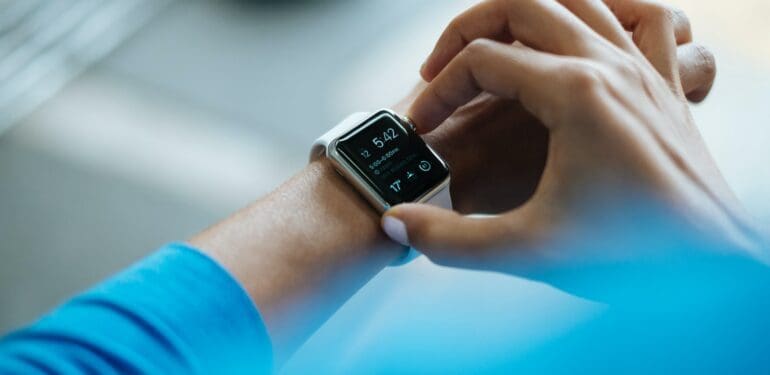We’re living in a tech-centric world, and it’s advancing at a rapid pace. Think of the advancements we’ve made in the last decade alone, and it can almost be overwhelming to consider where we’ll be in another decade.
Guest post by Katie Brenneman / Photo credit: Unsplash
For one, recent technology advancements have allowed a large portion to work from home and connect with others — even with a global pandemic running rampant. They’ve allowed surgeons to perform life-saving surgeries using robotics. They have even cut down on employee burnout and workplace stress by improving automation.
While all of those progressions are amazing, if you’re someone living with a disability, you might be interested in other types of tech advancements – things that are making daily life more accessible.
Things like voice-commanded technology, smart devices, and even 3D printing are all considered forms of accessible technology.
Whether you’re already taking advantage of some of these advancements or you want to learn more about how the tech world can make your life more accessible, we’ve got you covered.
Making Strides in the Metaverse
The metaverse is no longer just something they talk about in superhero movies. Many people believe it’s the future of the Internet. Essentially, the metaverse provides an immersive virtual experience that mirrors the real world.
Today, many people use it for gaming purposes. The popular game Fortnite is a great example of the metaverse at work. It offers an immersive experience, allowing players to socialize with each other and take part in “real-world” activities.
On a more practical level, the metaverse can be used for things like:
- Social interactions;
- Property ownership;
- Trade;
- Workplace meetings.
Most importantly, a large draw of the metaverse for most people is its accessibility. With tech advancements like 5G, users can jump into the metaverse and do things they might not be able to do in the real world without having to worry about lagging or poor connections. You can essentially create a version of yourself that’s a replica of who you really are or a version that depicts who you want to be.
If you deal with mobility issues, you might enjoy walking or running in the metaverse. If you have social anxiety, it may be easier to socialize in the metaverse. It may have started as a game, but it’s much more than that. It’s the opportunity to explore worlds that you might never get to experience otherwise and to find freedom in what you’re doing.
The Rise of Advanced Tech Equipment
Adaptive equipment for people with disabilities isn’t necessarily new. However, technology has made this kind of accessible equipment easier to use. Smart home technology, in particular, has made a difference for those who deal with mobility challenges.
For example, smart lamps can be programmed to send an alert to a smartphone when someone has fallen or gotten out of bed at night. Smart speakers can play announcements to other family members or caregivers if someone needs help.
Voice activation within these devices allows users to take control of basic house functions without getting up.
On a smaller scale, there are dozens of apps designed to improve accessibility and make life easier for people with disabilities. The Access Now app will let you know which nearby businesses accommodate guests with mobility issues. The AssistiveTouch app allows you to use single-tap shortcuts on your phone, so you don’t have to worry about mobility issues or arthritic conditions getting in the way.
Wearable tech devices have also become increasingly popular. Many people use wearable tech for things like fitness and tracking steps, heart rate, etc. These apps can also monitor your essential metrics for your health, which can be life-saving — especially if you have a chronic condition like diabetes or high blood pressure. If you have difficulty sleeping, wearable tech can even make it easier to manage your stress levels and help you relax, so you can get the rest your mind and body need.
Accessibility in the Workplace
Many workplaces have always prioritized inclusivity, as the ADA protects people with disabilities from discrimination. But, that doesn’t necessarily mean the work itself is always easy or accessible for everyone.
Technology has started to bridge that gap, making it easier for anyone to not only work where they want, but experience greater accessibility while there.
For example, remote work technology is a perfect example of technological accessibility. Now, any employee can work from home. Not only is this a significant relief for those who require mobility assistants, but also for those with mental health conditions who struggle in traditional workplace environments. This can be a handy tool not only for those with mobility challenges When you’re able to do a job from the comfort and familiarity of your own home, there are no limits. If you do have to work somewhere in person, it’s always a good idea to choose a job that promotes inclusivity and accessibility. Inclusive workplaces often include:
- Accessible entryways.
- Ramps;
- An open office layout;
- Office spaces conducive for those with ADHD, ADD, or ASD;
- Employee training on disabilities and accessibility.
If your current employer isn’t up-to-date with accessibility efforts, talk to them about implementing technology that can help. Screenreaders and smart devices alike not only make daily life easier, but they can make office work more productive. The technology is available, it’s just a matter of putting it in place. The more this technology is normalized across the globe, the easier it will be for people with disabilities to work in their desired industries — all without worrying how their condition might impede them.
Tech Advancements and Travel
Beyond work, tech has also allowed those with disabilities to travel the world and witness new sites. If you have a disability that has previously held you back from travelling, consider using technology to your advantage and jet-setting across the globe with ease.
You might have to do a bit more planning ahead than someone without a disability. But, that planning will work to your advantage. Nowadays, technology can streamline the process from booking a trip to getting around while you’re at your destination.
Many airlines have accessible features in place that make it easy for anyone to navigate the airport and airplane with ease. Some even go above and beyond. For example, Southwest Airlines offers pre-boarding for guests with assistive devices to ensure they get on safely and can travel comfortably.
If you’re concerned about how you’ll manage when you reach your destination, do a bit of research ahead of time. Destinations across the world offer experiences and accommodations specifically catered for those with disabilities. The AdvenChair, for example, is a new type of wheelchair built with the durability and stability of a mountain bike. With this bike, you can travel on any trail — no matter how steep or adventurous.
Anyone with visual impairments can also invest in gear like the OrCam My Eye – glasses that allow people with vision impairments to turn visual data into spoken word. Essentially, you’ll be able to hear what you’re “looking at” via a description from the glasses. Now, it’ll be easier to conceptualize even the most grandiose of cultural monuments across the globe.
Whether you deal with a chronic health condition, you’re visually or hearing impaired, or you struggle with mobility issues, technology’s ever-changing and ever-advancing journey forward will help to make life easier, more enjoyable, and more accessible.


